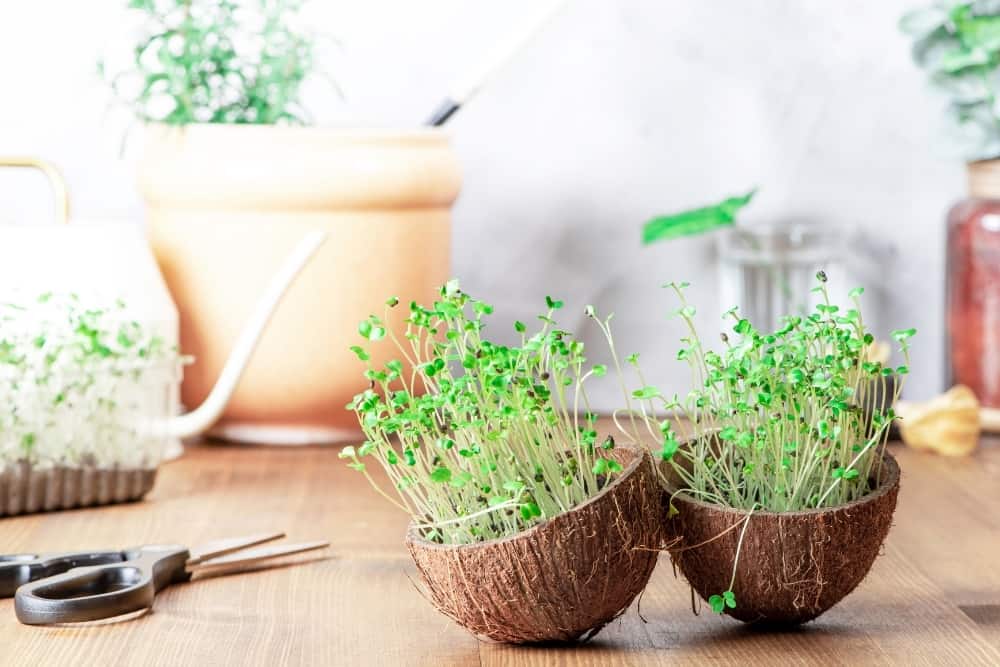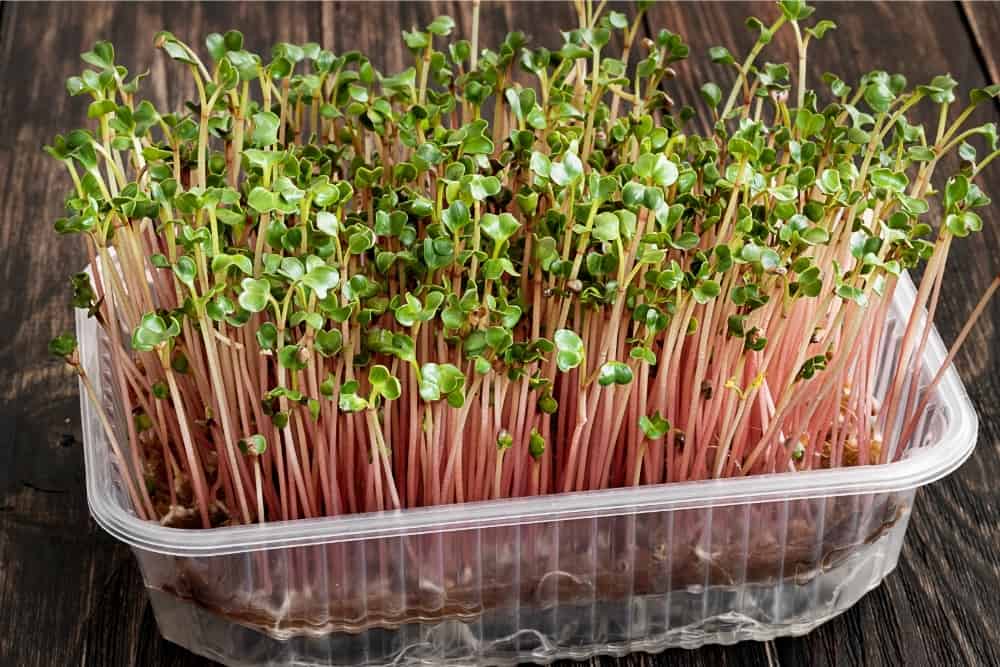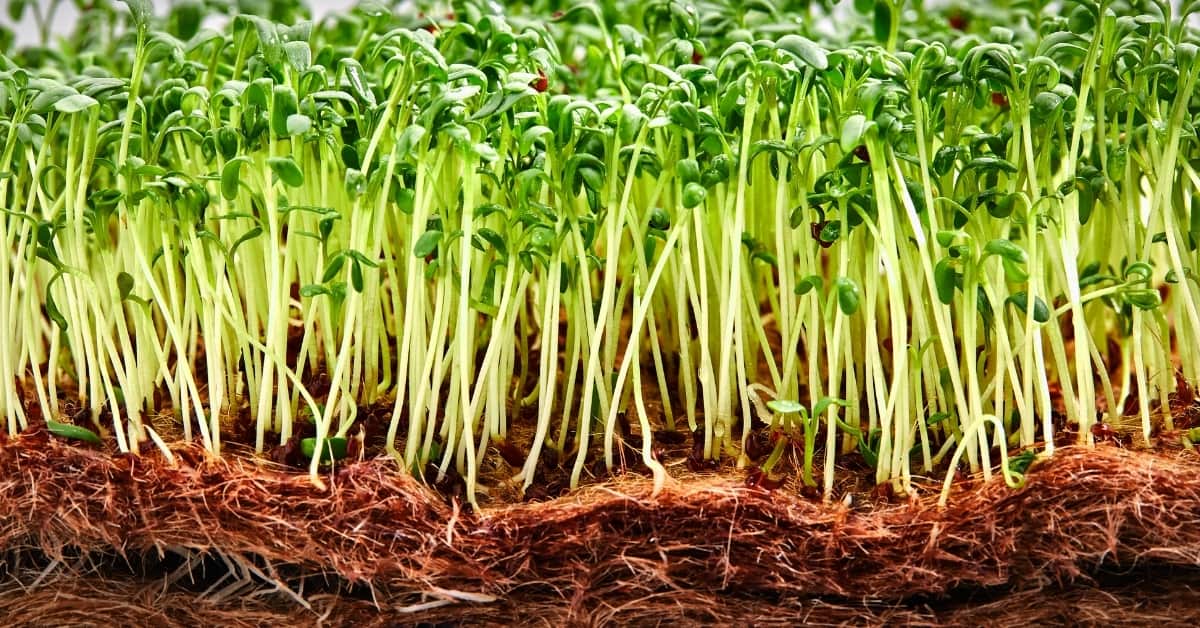This article entails the ultimate microgreens growing guide that will help you if you love gardening. We’ve cover important aspects of it!
Microgreens are one of the hottest things in the culinary industry right now. With popularity comes a severe increase in how much they are going to cost you. The good news is that you can grow your own microgreens at home, and it is a lot easier than you may think it is!
Microgreens are essentially just your standard greens, lettuce, and herbs that are harvested when they are very young. By growing your own microgreens indoors or outdoors, you are cutting down food costs for yourself and having the satisfaction of growing your own food.
While gardening your own food may seem intimidating, microgreens are one of the easiest ways to start, and they are not going to take up a lot of room. Let’s talk about what makes microgreens so popular and how you can grow them in the comfort of your own home or even yard.
What You Should Know
Instead of paying the high prices at your grocery store, try growing your own microgreens.
Not only are they relatively cheap to grow, but even if you are just a beginner, you will be able to find success with growing them. Microgreens are a great starting point because they can be grown both inside your home and outside. You can use a small planter or even a shallow dish to start growing your microgreens.
As with anything that you are growing, you need to be aware of what it needs to flourish, and the signs of it possibly being in trouble.
Microgreens are low maintenance and require minimal attention with regular watering and proper harvesting. When it comes to growing microgreens, you have three different categories, each feature unique needs, and challenges.
You can grow microgreens right in the comfort of your own home using a:
- Small pot,
- Planter box, or
- Even a plate.
They simply need mild temperatures, water, and a good sunny spot to grow.
If you are growing microgreens outdoors, you want to make sure that you place them in a planter box or protected area. You should also make sure to keep them watered and to avoid extreme temperatures that may kill your microgreens.
With microgreens, you are not limited as to where you grow them in terms of material as well. Microgreens are one of the many plants that thrive when they are grown hydroponically.
If you are concerned about having soil in your home due to pests or just a mess in general, hydroponics is an easy option to try. It is also a perfect solution for those who may not have good natural light in their home as well. It opens the door as to where you can grow your microgreens in your own home or outdoor space.
What are Microgreens?
Although they may seem like something that is new or trendy, microgreens have been around as long as your favorite greens or herbs. Since they are just young sprouts, they are typically eaten from the base up.
They are often harvested only when they are growing their first set of actual leaves. Microgreens are an ideal way for people to have access to healthy food in their own homes without taking up too much room.
What Kinds of Microgreens Can You Grow?
Most microgreens fall into the category of greens, leafy vegetables, herbs, and flowers. While you may only think of microgreens that are from something you see in a salad, the list of what you are able to grow is actually quite extensive. Here are a few of the types of microgreens that you can grow.
Large Microgreen Seeds
| Barley | Cilantro | Endive | Parsley |
| Buckwheat | Collard Greens | Fennel | Pea |
| Chard | Dill | Kale | Wheatgrass |
Medium Microgreen Seeds
| Arugula | Brussel Sprouts | Lettuce | Sesame |
| Basil | Cabbage | Mustard | Spinach |
| Broccoli | Chives | Radish | Turnip |
Small Microgreen Seeds
| Alfalfa | Lemon Balm | Oregano | Tarragon |
| Amaranth | Marjoram | Rosemary | Thyme |
| Celery | Mint | Sage | Watercress |
Are Microgreens the Same as Sprouts?
Although they seem to be the same, they are actually quite different. A sprout is what happens when a seed is just starting to grow. While you may see leaves, that does not necessarily mean your plant has begun. At this stage, you can eat the entire plant. The materials you use and how clean you keep your plant are essential at this stage because of how it is consumed.
Microgreens are plants that are past the stage of being just a seedling. They are starting to grow actual leaves for whatever seed you have planted. For microgreens, you leave the root of the plant and only utilize the stems or leaves. Since you are cutting the plant away from the root, you have to be less strict about the products you are using in terms of soil and containers. With that being said, you should still monitor them as they grow since they are ultimately going to be consumed.
Why You Should Grow Microgreens
One of the main draws of growing microgreens is how easy they are to grow. They do not need a lot of room or maintenance. Since microgreens can be challenging to find and expensive in grocery stores, this process cuts down the cost of microgreens and makes them available to you anytime you need or want them. They can also be used in a variety of dishes, which makes them incredibly versatile.
Microgreens are often categorized in the superfood category. Although they are seedlings, they can act as a great source of nutrients. They can be used to garnish dishes, buff up your favorite salads, or to add a big punch of nutrition to any dish. They can also be consumed raw, which means you are getting all of the vitamins and minerals that the microgreen has to offer.
Besides being rich in nutrients, they are also a sustainable source for those who may operate on lower-incomes or in smaller areas where finding good produce at a reasonable price may be challenging.
They are also rich in antioxidants, which are essential for our health and can even be catered to those with digestive needs or specific allergies.
How to Start Growing Microgreens
Now that you know what kind of plants you can grow, it is time to talk about how you can grow your own microgreens. Most people choose to start with seeds when growing microgreens.
As with anything you plant, make sure you read the packet to see what the needs and conditions are of the seeds. Most people separate their seeds by what their intended use is. Doing this can help you remember what they are as well.
Find a small container that is not too deep. You can have a formal growing tray, a pot, or even reusable containers or plates.
Since you are going to be harvesting your microgreens early, you do not need a deep container. Place some damp soil into the container and then lay your seeds on top of that soil. Press the seeds down into the soil and cover them all with one thin layer of soil or potting mix.
Starting with damp soil reduces the chances of your seeds drying out during the sprouting process. It will take a few days for your seeds to sprout, so keep an eye on your soil and make sure that it is not drying out.
Pro Tip: Using a mister will help keep your soil damp, but it will not drown your seeds either.
Where to Grow Microgreens
Most people grow microgreens indoors. Since you are harvesting them at such an early stage, having them indoors helps you keep an eye on them. Since microgreens are quick to grow and do not take up a lot of room, a sunny spot in your home is perfect.
On average, microgreens need at least four hours of good sun in order to grow. If your house is colder or you live in a colder climate, they may need more.
You can always find the light requirements for your microgreens on the seed pack. If you have a window facing the south, that will have the most amount of sun throughout the day and is where you should try and grow your microgreens.
If you have the space, you can also grow microgreens outdoors. You can use the same method to plant them in a bed or outdoor containers.
One thing to note is that you need to plant them where they have some amount of shade. Using too much light may cause them to dry out or not germinate properly. Make sure that you are routinely checking on your microgreens in an outdoor garden.
Tips for Growing Microgreens Indoors
Once you have planted your seeds in a small container, you want to make sure you are finding the sunniest area of your home. This would ideally be a windowsill in your home.

If you do not have an optimal area of your home to grow microgreens with the natural sun, then you can also choose to use an external light source such as a growing light.
Another benefit of growing your microgreens indoors is that you can control the climate and weather that they are subjected to. The ideal temperature to grow your microgreens is between seventy degrees and eighty degrees. You want the air to be warm, but you do not want the temperature to be too high as it could kill the plant.
Although you are not as likely to run into pests, some pests may get onto your microgreens. In addition to the plant no longer being clean or pest-free, it also diminishes the quality of your microgreens, and you may end up having to throw them away.
You can reduce the pest infestation by taking good care of your microgreens and giving them the best conditions possible. If you need to use some sort of spray or repellent, make sure you are choosing an organic product that will not ruin your microgreens.
Tips for Growing Microgreens Outdoors
Microgreens are typically grown in a controlled environment because you can create the ideal conditions for your microgreens to thrive. That does not mean that you cannot grow them outside. You may notice your plants growing at a slower rate than they would if they were indoors.
You want to make sure that you are using some sort of organic material as the main base of your microgreens. Using organic matter and compost feeds them the right amount of nutrients, as well as helping to make sure the soil drains properly.
If you live in an extremely hot climate, you may struggle with microgreens, but they can grow in direct sunlight. If possible, try and place your microgreens in an area that gets the recommended amount of sun as well as partial shade.
Your microgreens may need more water if they are subjected to extreme temperatures.
If you have access to an outdoor greenhouse, this is the ideal place to plant your microgreens. While you cannot control everything about your microgreens and how they grow, you can assist it along the way.
Similar to growing your microgreens indoors, you can help them along with an external light source if your greenhouse is in a darker area.
Can You Grow Microgreens Without Soil?
For those who are concerned about bringing soil into their home, or maybe are unable to find any near them, microgreens can also be grown without soil.

Hydroponic microgreens are a popular way of growing microgreens that uses water instead of soil. When using a hydroponic system, you can grow microgreens anywhere that you have the space to do so, and you never have to worry about watering your plants!
When growing microgreens hydroponically, you actually have more control over the process, and some of your microgreens may actually grow better! To grow your microgreens this way, you will need:
- Plastic trays,
- Seeds,
- External light sources,
- Fertilizers,
- A growing medium, and
- pH testing kits.
Before you start growing microgreens this way, make sure you have a pH ranging from 5.5 to 6.5. If your water is too acidic or basic, you can use lime or phosphoric acid to adjust the pH.
Once you have your water balanced, add any fertilizers or nutrients that you plan on using and make sure they dissolve entirely before moving on to the next step.
After a few hours, you can add your growing medium and let it begin to absorb the water.
Add your growing medium to the plastic tray and spread your seeds. Cover your seeds entirely until you start to see them sprouting. This could take up to a week, depending on external conditions.
Make sure you mist your seedlings until you begin to see leaves appear. You can then transfer your microgreens under an external light to grow.
How to Harvest Your Microgreens
As we mentioned earlier, the difference between when your microgreens are growing versus sprouting is a crucial step to remember.
The first sign is when your microgreens actually start growing small leaves of the plant you are trying to grow. If you are growing lettuce, then you want to wait for lettuce leaves to appear, not just the first sprout from the seed.
Your microgreens will regrow, so you want to take care of your plants during harvesting.
Use a pair of scissors and cut everything at the soil line. The roots of a microgreen are not edible, but you can enjoy the leaves and the stems of the plant you have grown.
Final Thoughts
Many people think that because a plant is hard to find or expensive to buy, they cannot grow it. Microgreens tend to be one of the plants that fall into that category. The truth is that microgreens are incredibly easy to grow, no matter your skill level when it comes to gardening. They can be grown in many different places, including both inside of your home and outside of your home.
Microgreens are one of the trendier plants to grow right now, but they are also incredibly beneficial to your diet. They are rich in antioxidants and nutrients and are among the most sustainable plants you can grow.
You can also use microgreens in many different ways. You can put them into smoothies, garnish your dishes, or even eat them raw to get the maximum benefits.
If you are interested in growing microgreens, make sure that you are getting high-quality seeds. You also need to make sure that you have the time to dedicate to maintaining your microgreens so that they stay in the best condition possible.
Use the items you have around your home to start growing them without having to make a significant investment.
Whether you are growing microgreens in soil or hydroponically, they are easy to grow and worth the effort.
If you have a good amount of natural sun or outdoor space, traditional growing methods can be fruitful when growing microgreens. The ability to grow them hydroponically only expands your options as to where you can grow microgreens.

